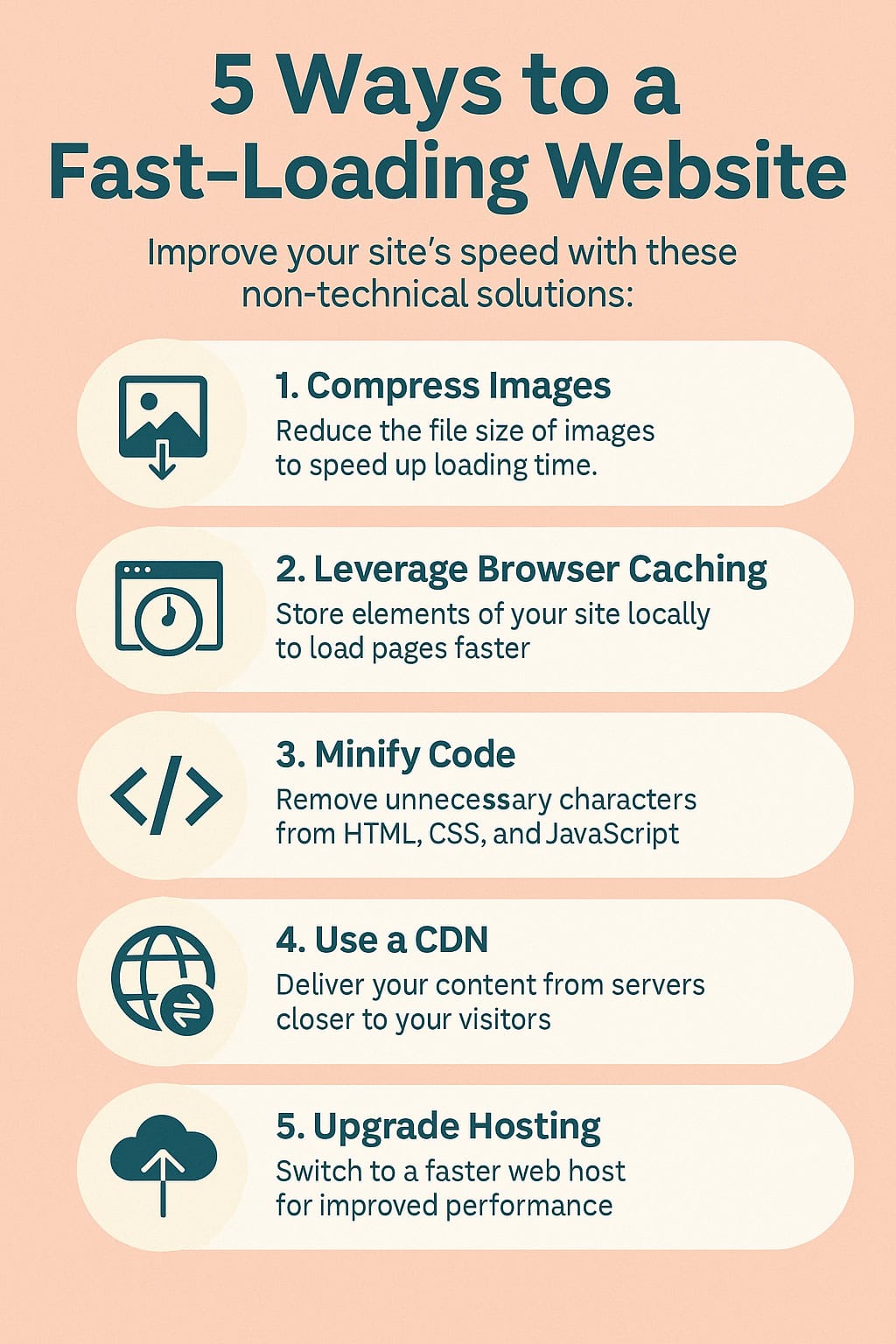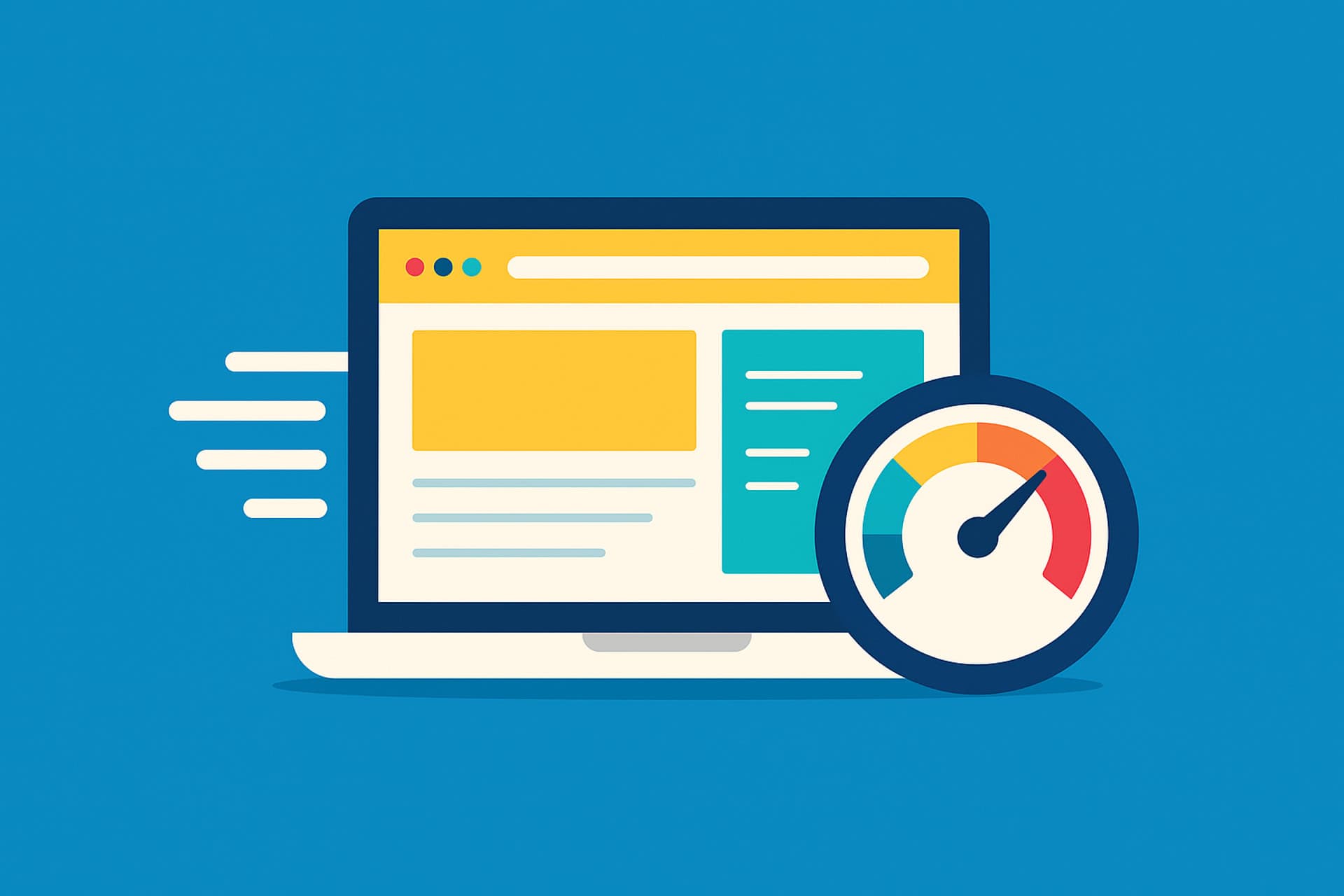Key Takeaways
A fast-loading website is essential for attracting and keeping local customers. Slow sites frustrate visitors, hurt your Google rankings, and cost you business. Speed builds trust, improves search visibility, and directly boosts conversions. Non-technical small business owners can improve load times with simple fixes like image compression, caching, and better hosting. Use free tools like PageSpeed Insights and GTmetrix to test your site. Want help? Start a chat with us to boost your site speed and grow your business.
Imagine you walk into a shop and the door sticks, you’d likely leave for the place next-door. The same thing happens online: if your fast-loading website stalls, visitors bounce to competitors. Site speed isn’t just a “techie” concern; it’s the silent handshake that decides whether a potential customer trusts you or taps away. Below, you’ll discover how load time shapes first impressions, search rankings, and ultimately, your bottom line.

First Impressions Are Formed in 50 Milliseconds.
How Speed Builds (or Breaks) Trust.
- Studies show users decide whether to stay on a page in as little as 0.05 seconds.
- A one-second delay can slash conversions by up to 7% and increase bounce rate by 32%.
- For local businesses, that could mean dozens of missed calls or walk-ins every day.
Take-away: A fast-loading website signals professionalism, reliability, and care for your customers’ time.
Page Speed & Local SEO: A Package Deal
Google’s Core Web Vitals Explained
For local SEO, Google rewards pages that load quickly, especially for local searches where users want answers now.
- Largest Contentful Paint (LCP): Aim for under 2.5s.
- First Input Delay (FID): Keep it below 100ms.
- Cumulative Layout Shift (CLS): Stay under 0.1 to prevent “page jump”.
Faster sites rise higher in local search results, appear more often in the “Map Pack,” and earn richer snippet features, putting you ahead of nearby competitors.
What Do LCP, FID, and CLS Mean for Your Website?
LCP (Largest Contentful Paint)
What it means:
How long it takes for the biggest thing on the screen — like a big image or a headline — to fully appear.
Why it matters:
It tells us how fast a website seems to load. If it takes too long, people might get frustrated and leave.
FID (First Input Delay)
What it means:
How quickly the website responds when you first try to do something — like clicking a button or tapping a link.
Why it matters:
A slow reaction makes the site feel unresponsive or “laggy,” which can be annoying.
CLS (Cumulative Layout Shift)
What it means:
How much the page “jumps around” as it loads — like when you’re about to click something and it suddenly moves.
Why it matters:
If things shift around too much, it’s confusing or frustrating, especially on mobile devices.
In short:
- LCP = How fast you see most of the page.
- FID = How fast the site reacts when you interact.
- CLS = How stable the layout is while loading.
Free Tools to Check Your Speed in Minutes
Tool | What it Tells You | Where to Find it |
PageSpeed Insights | Mobile & desktop scores, Core Web Vitals, fix suggestions | pagespeed.web.dev |
GTmetrix | Waterfall chart, historical tracking | gtmetrix.com |
Pingdom Website Speed Test | Real-time load timeline | tools.pingdom.com |
Quick, Low-Cost Fixes Even Non-Tech Owners Can Handle
Compress What Slows You Down
- Optimise images
- Use free tools like TinyPNG or ShortPixel.
- Choose modern formats (WebP or AVIF) that are up to 30% (or more) lighter than JPEG.
- Leverage browser caching
- Most website dashboards let you set caching rules in a few clicks.
- Minify code
- WordPress? Install plugins such as WP Rocket.
- Non-WordPress? Ask your developer to combine and compress CSS/JS files.
- Use a Content Delivery Network (CDN)
- Good hosting providers can use services like Cloudflare which also has free tiers that place your site closer to visitors.
- Upgrade hosting wisely
- Shared hosting can choke your speed. A basic managed plan often costs only a few dollars more but doubles performance.
Real-World Example: How One Mental Health Therapist Increased Bookings by 21%
Before: “AERCS Therapy” in Toronto had an 8-second mobile load time.
After: By compressing images and enabling caching, they reached 1.2 seconds.
Results in 30 days:
- +46% organic traffic
- 5× online therapy requests received
- +21% uplift in bookings
Speed became one competitive edge, without changing branding or website content.
Turn Speed into Sales Today
Fast pages attract, keep, and convert local visitors, it’s as simple as that. By trimming images, enabling caching, and testing regularly, you’re not tinkering with tech; you’re polishing your digital storefront.
💬 Ready to see how a fast-loading website can grow your business?
👉 Chat with us now to boost your site speed, and your sales.
FAQs
Why does my website need to load quickly?
A fast-loading website keeps visitors from leaving before the page appears. It builds trust, improves user experience, and increases your chances of converting visits into sales.
How fast should my website load?
Ideally, your site should load in under 2 seconds, especially on mobile. The faster, the better; many users leave if it takes longer than 2 – 3 seconds.
How can I tell if my website is too slow?
Use free tools like Google PageSpeed Insights, GTmetrix, or Pingdom. They’ll give you a score and recommend specific fixes.
I’m not a tech person, can I still improve my site speed?
Yes! Many fixes are non-technical, like compressing images, enabling caching (via your hosting settings or website plugins), or switching to better hosting.
What causes a slow-loading website?
Common culprits include large images, outdated or overloaded hosting, too many plugins, and bloated code.
Will improving my site speed help with SEO?
Definitely. Google considers page speed a ranking factor, especially for local and mobile searches. Faster sites rank higher and attract more traffic.
Can someone help me make my site faster without confusing me with tech jargon?
Yes, reach out to us for a friendly, jargon-free conversation about how to make your website faster and more effective for your business.

